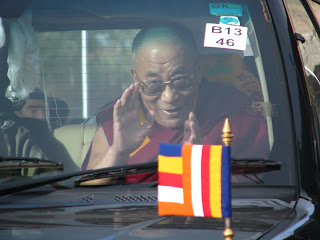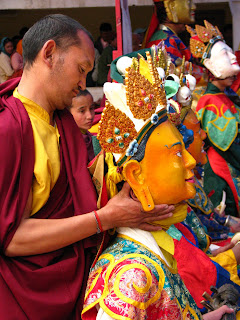From the temple of my beloved, I did roam,
To the house of the Lord from where I was thrown.
Wandering Babas invited me to smoke and talk,
When money was asked, from this place I did walk.
Then a Sadhu urged me to sit and drink chai,
But even this place I knew was not mine.
Searching, searching from each holy place to the next,
I found an empty chair where I decided to rest.
And there standing before me was the God of my temple,
Where I am always invited and the truth is simple
"To merge with the divine one must cease to covet,
For always united in One is the lover and her beloved."
Pushkar
Sunday, November 1, 2009
Monday, October 19, 2009
Sunday, October 18, 2009
Phuktal Gompa, Zanskar





The origins of Phuktal Gompa are said to be traced back to a monk who attained enlightenment in a cave 2000 years ago. It is from this cave that the Phuktal monastery arose in its present day form. Inhabited by over 70 monks and a three days walk from the main town of Zanskar one feels a million miles away from the 21st century.
The Dalai Lama's Teachings in Zanskar



Zanskar is one of the remotest Himalayan regions of Northern India and so consequently travel to and from there is one of the most difficult. That didn't stop thousands of Zanskaris and Ladakhis coming by road and many days walk in the mountains to arrive in the capital, Padum, for the three day teachings of the Dalai Lama.
Thousands of people with offerings and blessings waited to greet him as he arrived by helicopter. And later withstood heat, wind and dust to hear his lectures on Buddhist philosophies.
And his Holiness, always with his charming smile and humble appearance, satisfied many thousands who feared that this would be their last glimpse of him after a lifetime of reverence.
The Brokpa Community of Ladakh, India

Nestled on a small patch of fertile land and situated at the confluence of the Shayok and Indus river is the village of Dha Hanu, an Indo Aryan community of people thought to be descendants of Alexander the Great. They are visibly different from the mongoloid features of the Ladakhis who are primarily of Tibetan descent, and although Tibetan Buddhism has colored some aspects of their culture, they remain closer to their shamanistic roots.
Only 19 kms from the border with Pakistan, they are believed to be migrants from the Gilgit area where one can still see a similarity of culture and language. It is no surprise that there is a heavy military population in this sensitive border area.
One of the most striking features of these people are the fresh bouquets of flowers they wear atop their heads from where long pieces of braided hair hang. The traditional dress is slowly being discarded by the youth for a more modern and manageable attire, but one can still see the elders keeping to their traditions daily and at festival times.
Somehow the Brokpa community have managed to maintain the purity of their bloodline through the ages but being sandwiched between the giant religions of Buddhism and Islam and numbering only 2000 peoples in 5 villages, it is hard to imagine what their future will be.
Thursday, July 23, 2009
Wednesday, July 22, 2009
The Spirit of Spiti




Its hard to describe a land so vast and desolate and yet so rich in culture, color and spirit. The Spiti Valley shares the plateau and its heritage with Mother Tibet. Tibetan Buddhism has been practised here for centuries, and it colors the daily life of the people. The elderly chant "Om Mani Padme Hum" while spinning their prayer wheels. There are monasteries as old as 1500 years dotting the barren valleys with many monks still practising today.
And of course his Holiness the 14th Dalai Lama is the guru if not the celebrity of these people. I had the great fortune to listen to his teachings and be a part of the wild atmosphere when he visited the valley not too long ago. It was truly humbling to be in the presence of a great master and to be a fellow disciple of his with locals and foreigners alike.
With no further adieu I present you with the images that meagerly attempt to portray the glorious dignity of this special land.



The Cham Dance of Kungri




At the monastery of Kungri in the beautiful Pin Valley, the Cham festival was held to a great audience from many valleys. The dance, a form of meditation and an offering to the gods, is performed by monks dressed in exquisite silks and masks. The beat of the drum, the clash of symbals and the bellowing of ancient horns accompanies this ancient ritual of Tantric Buddhism.
Kesang of Kibber

Nestled in the mountains at an altitude of 4205 meters above sea level is the picturesque town of Kibber, where I made myself home for nearly three weeks. Why Kibber? Kesang.
Upon meeting this young woman I was already sure there was something different about her and that we would be great friends. During the cold nights I would stay in the kitchen with her while she cooked for other guests until I eventually became part of the staff. The kitchen became the backdrop for our intimate conversations and gossip and we would talk late into the night over chocolate pancakes!
Transcending cultural differences has always been an aim of mine while on the road. Whether it is with a smile, laughter or a deep meeting. I know the differences between us are only in our minds and what we have manifested from it. For me, knowing her was as much about knowing the women of India and relating that to my place in that same spectrum of womanhood.
Her world is one where women do not have the same freedoms that men do, but moreover it is a world where many people have one face for society and another for themselves.
But Kesang's advice to remedy that situation is simple.
WOMEN SHOULD LIE!!
Subscribe to:
Comments (Atom)




























